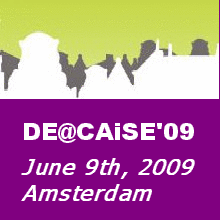 Projects
Projects 
The main projects I were (are) involved in in the last years are listed below.
Project #1: OPCAT (the Object-Process CASE Tool):
OPCAT
is a Computer-Aided Software Engineering (CASE)
tool that supports system development employing the Object-Process Methodology
(OPM). It has two different implemented versions:
OPCAT I was written in visual
C++ and supplies a graphical tool for drawing Object-Process Diagrams (OPDs).
It supports most of OPM symbols as well as their logic.
OPCAT II is designed to support
the full life cycle of developing an information system. Its major functionality is: System
Analysis & Design through Object Process Diagrams (OPD) and Object-Process
Language (OPL), Repository Management, Requirements Management, Implementation
Generation, Configuration Control, Multiple Users Support, Documents
Generation, Life Cycle Support.
For more information about OPM and OPCAT II, you can visit http://www.objectprocess.org/
Project #2: OPOSSUM:
OPOSSUM is a semantic search engine for Web Services. It relies on a simple and extensible keyword-based query language and enables efficient retrieval of approximate Web service compositions. Service instances, described by the languages such as Web Service Description Language (WSDL), are analyzed and their properties (e.g. inputs, results etc) are mapped to concepts. The concepts are borrowed from a set of ontologies, which formally describe domains such as medicine, e-commerce and insurance. The approach allows partial and inexact service modeling by augmenting ontologies with certainty values for concept mapping. The retrieval itself is driven by a matching engine that compares the query language's semantic and procedural constraints to the service models.
More about OPOSSUM can be found at http://dori.technion.ac.il/
Project #3: Liquid Interface:
Liquid Interface is a smart generator for usable user interfaces (prototypes) from semantic Web service compositions. It generates Web-based user interfaces by analyzing the semantic properties of compositions defined in OWL-S. Liquid-Interface applies an optimization technique to improve the usability of the user-interface, and specifically the way users navigate the application. The used ontologies improve the validation and online help options generated for the different user interfaces.
More about Liquid Interface can be found at http://dori.technion.ac.il/LiquidInterface/
Project #4: Semi-automatic Domain Modeling (SDM):
The Semi-Automated Domain Modeling (SDM) approach aims at creating draft models of domains from application models in those domains. It gets a repository of application models in a domain, matches elements according to linguistic, structural, and behavioral similarity measurements, and merges and generalizes the matched elements into domain models that include their common and different structural and behavioral aspects. The SDM domain models are specified using a domain engineering approach, called Application-based DOmain Modeling (ADOM).
More about ADOM and SDM can be found at http://mis.hevra.haifa.ac.il/~iris/research.htm
